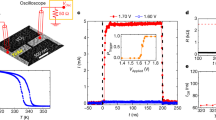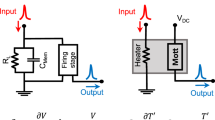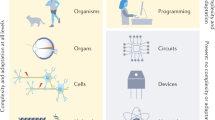Abstract
At present, machine learning systems use simplified neuron models that lack the rich nonlinear phenomena observed in biological systems, which display spatio-temporal cooperative dynamics. There is evidence that neurons operate in a regime called the edge of chaos1 that may be central to complexity, learning efficiency, adaptability and analogue (non-Boolean) computation in brains2,3,4,5,6,7. Neural networks have exhibited enhanced computational complexity when operated at the edge of chaos2, and networks of chaotic elements have been proposed for solving combinatorial or global optimization problems8. Thus, a source of controllable chaotic behaviour that can be incorporated into a neural-inspired circuit may be an essential component of future computational systems. Such chaotic elements have been simulated using elaborate transistor circuits that simulate known equations of chaos9,10,11,12, but an experimental realization of chaotic dynamics from a single scalable electronic device has been lacking5,6,13. Here we describe niobium dioxide (NbO2) Mott memristors each less than 100 nanometres across that exhibit both a nonlinear-transport-driven current-controlled negative differential resistance and a Mott-transition-driven temperature-controlled negative differential resistance. Mott materials have a temperature-dependent metal–insulator transition that acts as an electronic switch, which introduces a history-dependent resistance into the device. We incorporate these memristors into a relaxation oscillator14 and observe a tunable range of periodic and chaotic self-oscillations15. We show that the nonlinear current transport coupled with thermal fluctuations at the nanoscale generates chaotic oscillations. Such memristors could be useful in certain types of neural-inspired computation by introducing a pseudo-random signal that prevents global synchronization and could also assist in finding a global minimum during a constrained search. We specifically demonstrate that incorporating such memristors into the hardware of a Hopfield computing network can greatly improve the efficiency and accuracy of converging to a solution for computationally difficult problems.
This is a preview of subscription content, access via your institution
Access options
Access Nature and 54 other Nature Portfolio journals
Get Nature+, our best-value online-access subscription
$29.99 / 30 days
cancel any time
Subscribe to this journal
Receive 51 print issues and online access
$199.00 per year
only $3.90 per issue
Buy this article
- Purchase on Springer Link
- Instant access to full article PDF
Prices may be subject to local taxes which are calculated during checkout




Similar content being viewed by others
References
Chua, L., Sbitnev, V. & Kim, H. Neurons are poised near the edge of chaos. Int. J. Bifurc. Chaos 22, 1250098 (2012)
Bertschinger, N. & Natschläger, T. Real-time computation at the edge of chaos in recurrent neural networks. Neural Comput. 16, 1413–1436 (2004)
Seifter, J. & Reggia, J. A. Lambda and the edge of chaos in recurrent neural networks. Artif. Life 21, 55–71 (2015)
Kauffman, S. A. Requirements for evolvability in complex systems: orderly dynamics and frozen components. Physica D 42, 135–152 (1990)
Suzuki, H., Imura, J.-i., Horio, Y. & Aihara, K. Chaotic Boltzmann machines. Sci. Rep. 3, 1610 (2013)
Crutchfield, J. P. Between order and chaos. Nat. Phys. 8, 17–24 (2012)
Whitfield, J. Complex systems: order out of chaos. Nature 436, 905–907 (2005)
Chen, L. & Aihara, K. Chaotic simulated annealing by a neural network model with transient chaos. Neural Netw. 8, 915–930 (1995)
Hu, X., Chen, G., Duan, S. & Feng, G. in Memristor Networks (eds Adamatzky, A. & Chua, L. ) 351–364 (Springer, 2013)
Ditto, W. L., Murali, K. & Sinha, S. Chaos computing: ideas and implementations. Phil. Trans. R. Soc. Lond. A 366, 653–664 (2008)
Driscoll, T., Pershin, Y. V., Basov, D. N. & Di Ventra, M. Chaotic memristor. Appl. Phys. A 102, 885–889 (2011)
Wang, G., Cui, M., Cai, B., Wang, X. & Hu, T. A chaotic oscillator based on HP memristor model. Math. Probl. Eng. 2015, 561901 (2015)
Muthuswamy, B. & Chua, L. O. Simplest chaotic circuit. Int. J. Bifurc. Chaos 20, 1567–1580 (2010)
Pickett, M. D. & Williams, R. S. Sub-100 fJ and sub-nanosecond thermally driven threshold switching in niobium oxide crosspoint nanodevices. Nanotechnology 23, 215202 (2012)
Pickett, M. D. & Williams, R. S. Phase transitions enable computational universality in neuristor-based cellular automata. Nanotechnology 24, 384002 (2013)
Gibson, G. A. et al. An accurate locally active memristor model for S-type negative differential resistance in NbOx . Appl. Phys. Lett. 108, 023505 (2016)
Mainzer, K . & Chua, L. Local Activity Principle (Imperial College Press, 2013)
Ascoli, A., Slesazeck, S., Mahne, H., Tetzlaff, R. & Mikolajick, T. Nonlinear dynamics of a locally-active memristor. IEEE Trans. Circ. Syst. 62, 1165–1174 (2015)
Guckenheimer, J . & Holmes, P. Nonlinear Oscillations, Dynamical Systems, and Bifurcations of Vector Fields 117–165 (Springer, 1983)
Mannan, Z. I., Choi, H. & Kim, H. Chua corsage memristor oscillator via Hopf bifurcation. Int. J. Bifurc. Chaos 26, 1630009 (2016)
Chua, L. Memristor, Hodgkin–Huxley, and edge of chaos. Nanotechnology 24, 383001 (2013)
Chua, L. O. Local activity is the origin of complexity. Int. J. Bifurc. Chaos 15, 3435–3456 (2005)
Ott, E. Chaos in Dynamical Systems (Cambridge Univ. Press, 2002)
Pickett, M. D., Borghetti, J., Yang, J. J., Medeiros-Ribeiro, G. & Williams, R. S. Coexistence of memristance and negative differential resistance in a nanoscale metal-oxide-metal system. Adv. Mater. 23, 1730–1733 (2011)
Hopfield, J. J. & Tank, D. W. “Neural” computation of decisions in optimization problems. Biol. Cybern. 52, 141–152 (1985)
Kruse, R ., Borgelt, C ., Braune, C ., Mostaghim, S . & Steinbrecher, M. Computational Intelligence: A Methodological Introduction Ch. 8, 131–157 (Springer, 2016)
Hu, M . et al. Dot-product engine for neuromorphic computing: programming 1T1M crossbar to accelerate matrix-vector multiplication. In IEEE Conf. Design Automation http://ieeexplore.ieee.org/document/7544263/ (IEEE, 2016)
Kumar, S. et al. Spatially uniform resistance switching of low current, high endurance titanium–niobium-oxide memristors. Nanoscale 9, 1793–1798 (2017)
Shafiee, A. et al. ISAAC: a convolutional neural network accelerator with in-situ analog arithmetic in crossbars. In Proc. 43rd Int. Symp. Computer Architecture 14–26, http://ieeexplore.ieee.org/document/7551379/ (IEEE Press, 2016)
Acknowledgements
The research is in part based on work supported by the Office of the Director of National Intelligence (ODNI), Intelligence Advanced Research Projects Activity (IARPA), via contract number 2017-17013000002. We thank L. O. Chua for reviewing the manuscript, discussions and data analysis. We also thank G. Gibson for discussions and insights.
Author information
Authors and Affiliations
Contributions
All authors contributed to the conception of the idea, design of experiments, construction of the model, data analysis and writing of the manuscript. S.K. primarily set up experiments and collected experimental data. S.K. and J.P.S. together ran the simulations of the models. R.S.W. conceptualized the static model, the inclusion of thermal noise in the dynamical model, and determined the relevance of chaos in computational systems. J.P.S. had the specific idea of using chaos for accelerating solutions in Hopfield networks.
Corresponding authors
Ethics declarations
Competing interests
The authors declare no competing financial interests.
Additional information
Reviewer Information Nature thanks W. Ditto, Z. Toroczkai and the other anonymous reviewer(s) for their contribution to the peer review of this work.
Publisher's note: Springer Nature remains neutral with regard to jurisdictional claims in published maps and institutional affiliations.
Supplementary information
Supplementary information
This file contains Supplementary Text and Data and Supplementary Figures 1-20. (PDF 1995 kb)
Rights and permissions
About this article
Cite this article
Kumar, S., Strachan, J. & Williams, R. Chaotic dynamics in nanoscale NbO2 Mott memristors for analogue computing. Nature 548, 318–321 (2017). https://doi.org/10.1038/nature23307
Received:
Accepted:
Published:
Issue Date:
DOI: https://doi.org/10.1038/nature23307
This article is cited by
-
High-order sensory processing nanocircuit based on coupled VO2 oscillators
Nature Communications (2024)
-
Chalcogenide Ovonic Threshold Switching Selector
Nano-Micro Letters (2024)
-
A general discrete memristor emulator based on Taylor expansion for the reconfigurable FPGA implementation and its application
Nonlinear Dynamics (2024)
-
Investigation and mitigation of Mott neuronal oscillation fluctuation in spiking neural network
Science China Information Sciences (2024)
-
Exploring thickness-dependent Cu/TiOx:Cu/Ti memristor and chaotic dynamics in a real fifth-order memristive circuit
Nonlinear Dynamics (2024)
Comments
By submitting a comment you agree to abide by our Terms and Community Guidelines. If you find something abusive or that does not comply with our terms or guidelines please flag it as inappropriate.



